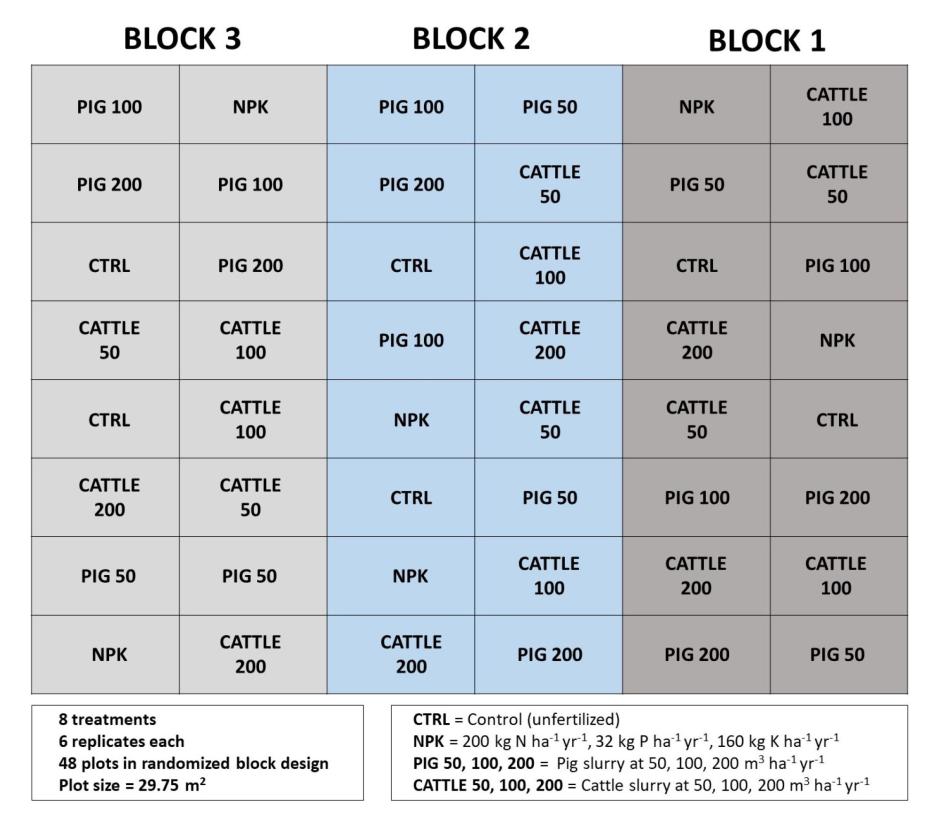Long-term effects of nutrient fertilization on grassland
The long-term nutrient fertilization experiment was established in 1970 to measure the effects of frequent applications of organic (i.e. animal slurry) and inorganic (i.e. NPK) nutrients on plant productivity and soil biogeochemistry.
Outline of experiment
The experiment consists of eight treatments: (1) unfertilized control, (2) inorganic fertilizer (200 kg N, 32 kg P, 160 kg K ha-1 year-1), organic nutrient fertilization applied as three pig slurry levels (3) 50, (4) 100 or (5) 200 m3 ha-1 year-1, and organic nutrient fertilization applied as three cow slurry levels (6) 50, (7) 100 or (8) 200 m3 ha-1 year-1. There are six replicates for each treatment thus giving 48 plots in a randomized block.
The fertilizer and slurries are applied in three equal dressings, first in the spring and then immediately after the first two cuts. The herbage is cut three times at the silage stage. Soil samples are collected at three depths in February. Air dried soil is analysed for pH, extractable P and exchangeable K and Mg. Oven dried herbage is digested and subjected to multi-element analysis.d in folder.
Main results
- Mean annual herbage yield has increased with increasing application rate of both types of slurry. Herbage yield shows a highly significant response to applied inorganic nitrogen.
- Sward botanical composition has changed markedly. Although the low application rate of slurry has maintained perennial ryegrass at 50-60% of the herbage dry matter, the highest application rate has lowered it to about 10%. The principal invading grasses are creeping bent and Poa spp.
- High slurry application rates have led to low Mg concentrations in the herbage despite accumulation of exchangeable Mg in the soil. This is probably due to antagonism between the uptake of K and Mg from the soil.
- High slurry application rates have led to marked accumulation of extractable P (particularly pig slurry) and exchangeable K (particularly cow slurry) and Mg in the soil profile.
- No lime was applied during the first 22 years and increasing application rate of pig slurry lowered soil pH almost as much as the fertilizer control, whereas cow slurry acted as a liming material, with no decrease in soil pH at the highest application rate.
- Zn and Cu have accumulated in the soil under the highest rate of pig slurry, Cu to over 90% of the UK maximum permitted concentration in grassland soils receiving sewage sludge applications.
- A significant decrease in soil microbial biomass under the highest application rate of pig slurry has been attributed partly to lower soil pH but also to accumulation of Cu and Zn.
- A significant decrease in arbuscular mycorrhizal colonization with increasing application rate of both types of slurry is related to soil extractable P, but stepwise multiple regression analysis has indicated that soil Zn and pH are also important explanatory variables.
- The relationships between slurry application and silage quality are complex, but any deleterious effects (particularly of cow slurry) can be avoided by using an inexpensive and readily available bacterial silage additive.
- Long-term high application rates of slurry can significantly increase soil exchangeable sodium and this may increase the risk of loss of phosphorus from soil to surface waters.
- A 15N tracing study showed that long-term cow slurry application led to a shift toward a greater predominance of mineralization from labile organic N with increasing slurry application rate and the oxidation of recalcitrant organic N shifted from a predominant NH4+ production in the unfertilized control toward a predominant NO3- production (heterotrophic nitrification) in the cow slurry treatments.
- Soil C content has been increasing more under cow slurry applications compared with pig slurry applications and with NPK fertilization.
- In terms of changes in microbial communities we found that amoA genes of ammonia-oxidizing archaea (AOA) significantly increased under cow slurry applications, whereas ammonia-oxidizing bacteria (AOB) increased with the addition of inorganic N.
Layout of the long-term experiment

1. FE CTRL - Fertiliser supplying 200 kg N ha-1year-1, 32 kg P ha-1year-1 and 160 kg K ha-1year-1
2. UF CTRL - Fertiliser as above for three years and then no treatment
3.- 5. PIG 50 - PIG 200 : Pig slurry at 50, 100 or 200 m3 ha-1 year-1
6.- 8. COW 50 - COW 200 : Cow slurry at 50, 100 or 200 m3 ha-1 year-1
8 TREATMENTS x 6 REPLICATES = 48 PLOTS IN A RANDOMIZED BLOCK DESIGN (see the 3 blocks identified with different colours)
PLOT SIZE = 29.75 m2